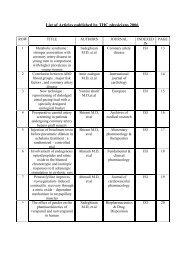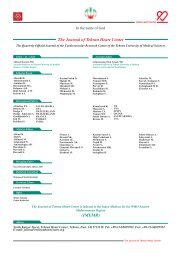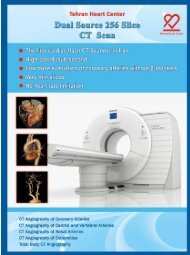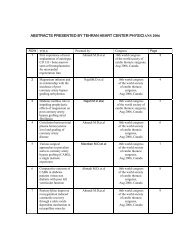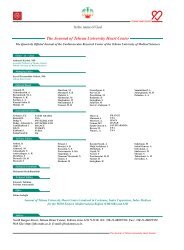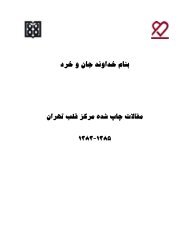THE JOURNAL OF TEHRAN UNIVERSITY HEART CENTER
THE JOURNAL OF TEHRAN UNIVERSITY HEART CENTER
THE JOURNAL OF TEHRAN UNIVERSITY HEART CENTER
You also want an ePaper? Increase the reach of your titles
YUMPU automatically turns print PDFs into web optimized ePapers that Google loves.
The Journal of Tehran University Heart Center<br />
TAPSE and Sa both in the control (r = 0.755, p value < 0.001)<br />
and patient (r = 0.662, p value = 0.002) groups. There was<br />
a significant inverse correlation between Sa and RVMPI (p<br />
value = 0.001) in the control group but not in the patient<br />
group (p value = 0.054). There was no significant correlation<br />
between RVMPI and Ea/Aa in either group.<br />
PRi was measured in all the totally corrected T<strong>OF</strong> patients,<br />
of whom 13 had a value ≥ 70% (mild PR) and 17 had a value<br />
< 70% (moderate to severe PR). PRi < 50% was found in 2<br />
patients. There was a significant correlation between RVMPI<br />
and PRi (p value < 0.001) in the patient group. The RVMPI<br />
in patients with PRi < 70% was 0.42 ± 0.13, which differed<br />
significantly from the RVMPI (0.24 ± 0.1) in the patients<br />
with PRi ≥ 70% (p value < 0.05). In the 2 patients with PRi <<br />
50%, RVMPI was 0.62 and 0.47, respectively. There was no<br />
significant difference in the Ea/Aa ratio between the patients<br />
who had PRi ≥ 70% and those who had PRi < 70% (p value<br />
= 0.38). The Ea/Aa ratio was insignificantly higher in PRi<br />
< 70% (2.1 ± 9.4 vs. 1.85 ± 7.4; p value = 0.405). In the 2<br />
patients who had PRi < 50%, the Ea/Aa ratio was 4.57/1 and<br />
2.92/1, respectively (restrictive pattern).<br />
In the color flow Doppler assessment of PR, 11 patients<br />
had mild PR and 19 had moderate to severe PR. There was a<br />
significant correlation between PR severity in the retrograde<br />
color flow mapping and RVMPI (p value = 0.023), but there<br />
was no correlation between PR severity and Ea/Aa ratio (p<br />
value = 0.38).<br />
Discussion<br />
Advances in cardiac surgery and postoperative<br />
management in the developed countries have contributed<br />
to the excellent long-term outcome of the totally corrected<br />
T<strong>OF</strong> patients; 1 nevertheless, the long-term outcome of<br />
the corrected T<strong>OF</strong> surgery in developing countries is<br />
unknown. 5, 6 In the developed countries, PR and RV<br />
diastolic dysfunction is the most important outcome factor<br />
following the T<strong>OF</strong> repair. 2, 3 There are reports of the usage<br />
of pulmonary valve sparing surgery to decrease the severity<br />
of PR in the T<strong>OF</strong> patients. 11, 12 Intra- and postoperative<br />
management problems, delay in corrective surgery, and<br />
palliative surgery (aorto-pulmonary shunts) are probably<br />
additional contributory factors to the poor long-term<br />
outcome in developing countries. 5, 6 At follow-ups of the<br />
repaired T<strong>OF</strong> patients, simple and fast evaluation of the<br />
systolic and diastolic RV functions is of great importance.<br />
In our study, the RV systolic and diastolic function indices<br />
were clearly impaired in the T<strong>OF</strong> patients in comparison with<br />
the normal children at mid-term follow-ups (Table 1). A few<br />
studies have focused on the RV function at mid-term followup<br />
after the T<strong>OF</strong> repair. Pilla et al. evaluated the presence<br />
of mid-term RV dysfunction and health-related quality of<br />
life after the T<strong>OF</strong> repair in Brazil. 13 In their investigation,<br />
Asadolah Tanasan et al.<br />
35 patients at a median age of 6.1 years and 4.9 years of<br />
follow-up after surgery were compared with 36 sex- and<br />
age-matched healthy controls and RVMPI (0.34 vs. 0.2)<br />
demonstrated RV dysfunction in the patients compared with<br />
the controls. In adult patients late after the repair of the T<strong>OF</strong>,<br />
D’Andrea et al. detected a correlation between myocardial<br />
performance assessed at rest via tissue Doppler (TD) and<br />
cardiac performance during physical effort in adult patients<br />
(21.4 ± 3.8 years). 4 In their study, TD analysis showed lower<br />
Sa, Ea, Ea/Aa ratios in the corrected T<strong>OF</strong> patients compared<br />
to the normal group. In contrast to our study, the corrected<br />
T<strong>OF</strong> patients of their study had no significant PR, the mean<br />
age of the T<strong>OF</strong> patients was higher than that in our study<br />
(21.4 ± 3.8 vs. 6.3 ± 3.3 years), and the mean age of the<br />
corrected T<strong>OF</strong> patients was lower than that in our study (1.4<br />
± 0.5 vs. 3.6 ± 3.2 years). 4 In the Puranik et al. study, Sa<br />
and Ea were significantly lower in asymptomatic corrected<br />
adult T<strong>OF</strong> patients compared with their normal group. 14<br />
Similar to our study, there was significant PR but the age at<br />
corrective surgery was higher (6.6 vs. 3.6 years). Although<br />
the increased Ea/Aa ratio in our study, in contrast to the<br />
D’Andrea’s, may suggest the role of combined prolonged<br />
cyanosis and post-correction PR, a comparison with the<br />
Puranik study emphasizes the importance of other factors in<br />
4, 14<br />
the restrictive diastolic RV dysfunction in our patients.<br />
On the other hand, while our study demonstrates combined<br />
systolic dysfunction (decrease in both Sa and TAPSE) and<br />
restrictive RV dysfunction (increase in Ea/Aa ratio), the two<br />
other studies 4, 14 showed mild systolic dysfunction (decrease<br />
in Sa) associated with a significant decrease in Ea/Aa in adult<br />
corrected T<strong>OF</strong> patients. Frigola et al. reported that PR was an<br />
important factor of RV contractile dysfunction after the T<strong>OF</strong><br />
repair. 15 These observations may suggest that the systolic and<br />
restrictive diastolic RV dysfunctions in our study probably<br />
originated through others mechanisms and they were present<br />
since the early postoperative period. In a study by Cullen<br />
et al, 16 patients with early restrictive physiology after the<br />
T<strong>OF</strong> repair had a clinical picture of low cardiac output and<br />
slow postoperative recovery but a study by Gatzoulis et al.<br />
suggested that late restrictive physiology predicted a superior<br />
exercise performance. 17 Further studies are clearly warranted<br />
about how the RV systolic and diastolic functions correlate<br />
with intra- and early postoperative management and PR.<br />
In addition to significant PR and prolonged preoperative<br />
cyanosis, intra- or early postoperative management may<br />
have been affected by systolic and restrictive diastolic RV<br />
functions in our study. 6 Although RVMPI was significantly<br />
correlated with PR severity (retrograde color flow and PRi),<br />
there was no significant correlation between RVMPI and<br />
Ea/Aa ratio. In our 2 patients with severe PR (PRi < 50%),<br />
the Ea/Aa ratio was significantly elevated. As RVMPI was<br />
not correlated with systolic and diastolic function indices<br />
(Sa, TAPSE, Ea, and Ea/Aa) but was allied to PR severity,<br />
RVMPI may have been affected more by PR severity than<br />
162



